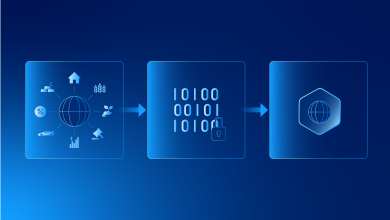A New Frontier for Artificial Intelligence
Artificial intelligence, as a concept, has never been able to do without data, one thing, in particular, has always been in the foreground. The data was better, the model was smarter. For years, businesses have been using online behavior, sensors, and enterprise systems to provide data for algorithms. However, now there is a new kind time of data source that is changing the way AI learns and functions: data collected from space.
One can no longer confine satellite data to only those who have the money and the technology i.e. governments and big space agencies. It is slowly but surely becoming a part of the AI infrastructure. The inflow of real-time earth observation data from the latest hundred or so satellites launched every year is revealing new possibilities in AI that were not even considered ten years ago.
The convergence of AI and space technology is not only changing the agricultural industry and supply chain management but also is helping to fight global warming and is the base of the development of the next generation of robots. What used to be software dependent on static datasets is evolving due to continuous updating of information streams that are dynamic, global, and available 24/7.
The Power of Perspective
Satellite data is essentially different from others because of its extent and impartiality. It gets the data about the whole planet not from the ground but from the air. Such a planetary view gives AI systems the ability to comprehend the changes made in a certain period with a great deal of accuracy which is beyond the capability of local data sources.
Using machine learning models on satellite images, one can detect crop health, track deforestation, predict infrastructure risks, and even monitor carbon emissions. In conjunction with other data streams, this multi-layered view provides the organizations the power to respond quickly not only to the challenges but also to the opportunities at a global level.
Changes still outpace our recording abilities in a world that satellites become our common sensors carrying data to AI about the world’s heartbeat in real time.
The Convergence of Space Tech and AI
The technologies used for space have gone a long way besides just rocket launches. The current satellite constellations are actually one of the elements of a bigger digital ecosystem that also features high data rate links, cloud storage, and edge computing capabilities. All these together allow AI systems to be able to handle huge volumes of imagery, telemetry, and environmental data in a very efficient way.
On the other hand, AI keeps on adding to the value of the data by means of its analysis in the manner which humans are not able to. Deep learning models can detect automatically, through vast amounts of satellite images, the occurrence of anomalies, the classification of the earth’s surface, or even the prediction of weather disruptions. Such scalability is only possible if both algorithms and space infrastructure are updated simultaneously.
In such sectors as insurance, agriculture, and transportation, this convergence is already producing the tangible outcomes that can be measured. Enterprises are employing AI powered by satellites to check disaster impacts in a much quicker way, make supply chains more efficient, and handle natural resources at a level of accuracy never before seen.
And behind many of these breakthroughs are companies that provide specialized intelligence and market insights into how satellite technologies and data analytics are converging to drive AI application development across sectors. These insights guide investors, researchers, and developers to better understand where the next wave of opportunity will emerge as Earth observation meets artificial intelligence.
How Satellite Data Supercharges Machine Learning
Machine learning models benefit from diverse and voluminous data. In fact, satellites are providing these large, continuous, and multi-dimensional streams of data. Compared to human-generated datasets, satellite imagery records the reality of the situation, thus, it is the least biased and most objective.
To AI developers, this is a dream come true. A model to predict urban expansion or to track environmental change needs such reliable and timestamped data for several years or even decades. Digitized records from satellites give the continuity that allows the models to not only comprehend the phenomena but also the associations and reasons.
Moreover, satellite sensors emit and collect light in multiple wavelengths visible, infrared, radar, and so on, thereby giving AI the ability to see what human eyes cannot. Such a degree of depth fosters innovations not only in the areas of climate modeling, mining, precision agriculture but also in national security.
If the preprocessing pipelines are set properly, AI can combine satellite images with ground data, social indicators, and IoT streams to create models that are capable of understanding the earth as a living, ever-changing system.
Real-World Applications on the Rise
The combination of satellite and AI has changed the face of various sectors. On the farming side, machine learning systems supported by satellite images can even recognize the symptoms of drought, pest attacks, or nutrient shortages thus enabling the growers to get the prompt and practical solutions well before the issues spread.
AI routines in logistics and maritime are using satellite data to trim the shipping routes, forecast the port congestion, and check the fuel efficiency. The Environment watchers are employing it to keep track of ice melting, changing ocean currents, and deforestation rates which they then use as input for the climate models to make the accurate and reliable predictions to help in making the policy decisions.
Even urban planners have combined this duo to help them chart the growth of cities, form the lines for the transportation networks, and spot the energy-saving possibilities from space.
For the programmers and data scientists, these examples of usage are giving birth to the novel frameworks for AI model design. Rather than considering earth observation data as a mere external input, it is turning out to be the main data architecture that drives algorithmic innovation.
Overcoming the Data Challenge
The difficulties of using satellite data can be understood from the fact that the raw images are usually unstructured, very large, and have been taken under different conditions. To process such data, one needs to have special-purpose algorithms that can remove noise, adjust for atmospheric interference, and geometrically transform the images to a common grid.
Machine learning methods, in particular deep convolutional networks, can perform a large part of this preprocessing automatically, thus AI is able to free human labor in this field.
Moreover, the barrier to entry is being lowered by the access to open data initiatives from organizations such as NASA, ESA, and private satellite companies. Startups and research labs, therefore, are able to experiment with the new methods of combining data streams from space with terrestrial analytics as the data gets more accessible and the computation more affordable.
Accelerating Innovation Through Collaboration
It is impossible for one company to understand both the quantum-level computation and the planetary-scale observation. The rapid development of AI through space technologies can only be achieved by a close collaboration of satellite operators, data scientists, software engineers, and policymakers.
New companies are creating APIs that allow developers to use Earth observation data. Service providers in the cloud are embedding satellite analytics straight into their machine learning platforms. Authorities are financing research programs that link AI innovation with sustainability goals.
This interconnected network is what transforms space technology from an elitist capability into a shared resource. Moreover, as these collaborations expand, AI systems become not only more intelligent but also more global in perspective.
The Economic and Strategic Impact
Technological aI driven by satellite has relatively well-known economic effects, in the background. Such a fundamental change has been the reshaping of entire industries through the ability to real-time prediction and response starting from agriculture yields and disaster response to energy consumption and trade logistics.
Investors are not turning a blind eye to this trend. The intersection of space and AI becomes one of the most attractive technological investment frontier, which is enticing the capital of both sectors, private and public. The companies which will strategically position themselves early in this ecosystem will be able to set new standards of sustainability, security, and global infrastructure.
Also at a strategic level, the countries are recognizing the value of AI powered by satellites in terms of geopolitics. The capability to observe worldwide activities from space and understand such data using machine learning is quickly establishing itself as the basis of contemporary intelligence and defense systems.
The Future: A Planet Powered by Shared Intelligence
Over the next ten years, most AI applications will depend a lot on real-time data gathered from the Earth. With satellites being smaller, less expensive, and more networked, they will be like a distributed neural network around the Earth that is constantly observing, learning, and updating human systems.
Programs built on such a basis will not merely be reactive to data, but they will also be proactive. City planners will have the ability to simulate future growth even before it happens. Power grids will change to the weather conditions automatically. Nature conservation bodies will be able to foresee the ecological threats before they happen.
There is a close interaction between AI and space technology which in many aspects reflects the same as the human progress one intelligence broadening its horizons. By combining orbital surveillances with algorithmic processing, we are not only instructing machines to “see” the world, but also to “understand” it.
Moreover, the possibilities for innovation become unlimited as this understanding grows. The subsequent breakthroughs in AI will not be only because of better coding or faster chips, but due to broader vision which is a real planetary perspective made possible by the satellites, space technologies, and the intelligence that we put on them working together.



